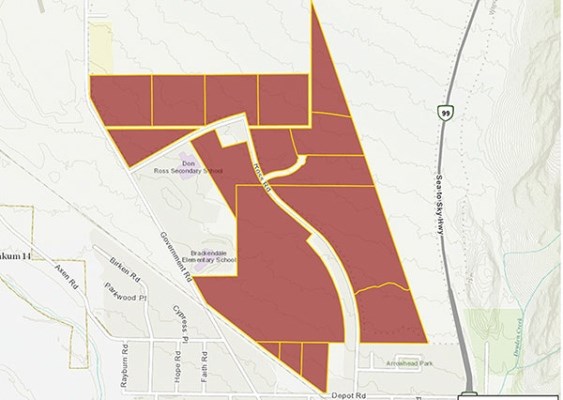In the end, it came down to a show of good faith.
Council passed first reading of the Cheekye River Development in spite of an original recommendation from District of Squamish staff that first reading be defeated – and in spite of several concerns staff and council expressed over the proposed 750-house development and the debris flow barrier needed to protect it.
It was an impassioned speech by Squamish Nation councillor Chris (Syeta’xtn) Lewis, in front of a chamber audience that included Squamish Nation council members and elders, that convinced the district councillors to support a new resolution in favour of the first reading.
Lewis spoke of a feeling that a trust would be broken between the district and the nation if the development was defeated at first reading.
“Since the signing of the protocol agreement, a government-to-government relationship based on trust has been developed, it has been re-established and significant progress has been made,” Lewis said.
“As you are aware, the Cheekye Fan development is of great significance to the Squamish Nation and for the safety of the Squamish Nation people and our community. Our community has been at risk for some time,” Lewis said, referring to Squamish Nation communities already in the hazard zones around the site of the proposed development.
“Unfortunately the district has put our investment and the protocol agreement at risk,” he said. “We can not maintain our continued support of the district of Squamish aspirations articulated within the protocol agreement while you ignore ours around the Cheekye fan.”
Lewis then read part of the alternative resolution, eventually passed, that stated that Squamish Nation representatives and district mayor and council would go to the province together to ask for funding the barrier maintenance and operation.
In 2011 an Intergovernmental Cooperation Accord was signed between the Squamish Nation and the district. The accord said the Squamish Nation could apply to the province for ownership of about 200 acres of the Cheekye Fan lands and it could apply to the district for development approval for single-family residential housing and commercial development on the land.
The original district staff recommendation to vote down the project on first reading was based on several concerns of the district; chief among them was concern over the cost of the debris flow barrier to the district, according to a report presented to council by district staff Tuesday night.
The 35-metre tall barrier and other mitigation works for the proposed development would be built by Cornerstone Developments Ltd. (a partnership between the Squamish Nation and the developer), but the cost of operating and maintaining the barrier would fall on the district. There is no other infrastructure of its size in North America, so real cost comparisons can’t be done, the report states, but clean-up after a single event could cost the district millions.
Several councillors said they had come into the meeting planning to defer the decision on first reading but had changed their minds after hearing Lewis and seeing the show of support by the Squamish Nation.
“I have gone back and forth because from a planning point of view, really, you should be making a first reading based on a certain criteria,” Mayor Patricia Heintzman said. “But I appreciate the fact that it would be a positive gesture to our community partners, the Squamish Nation.”
The resolution passed unanimously.
After the meeting, Lewis said what council decided heartened him.
“It is really exciting that there was a vote of good faith around continuing the relationship of reconciliation among both of our governments, and also saying that we are going to work together,” he said.



